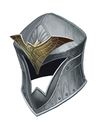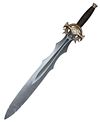How Magic Armor and Weapons Work in PF
First Steps
- Only a masterwork item may be enchanted
- An armor or weapon must first possess a +1 Enhancement bonus before gaining an Effect bonus (explained below)
- The PRD does not refer to Enhancement and Effect bonuses separately; the meanings must be inferred from the text
- This tutorial uses the different terms for enhanced clarity, though the rules do not differentiate from that of the PRD
What Can I Add to Armor or Weapons?
Enhancement bonuses: An enhancement bonus on an armor or weapon is a "flat" bonus that adds to an armor or weapon's general effectiveness.
- An armor Enhancement bonus:
- Adds to the armor's AC (a +2 breastplate would have an AC 2 higher than normal)
- Adds to the armor's hardness
- A weapon Enhancement bonus:
- Adds to the weapon's to-hit and to-damage (a +2 longsword has +2 to hit and damage)
- Adds to the weapon's hardness
- Increases the weapon's ability to overcome Damage Reduction
Effect bonuses: An effect bonus does sparkly things.
- An armor's or weapon's Effect bonus:
- Does a unique thing, such as resisting or causing fire damage
- The value of this "thing" is expressed in a +X value
Can I Upgrade My Existing Weapons or Armor?
Generally, the answer is "yes."
The basic rules when adding enchantments are:
- 1. A weapon or armor must have a +1 Enhancement bonus before adding any type of Effect bonus
- 2. To determine the cost of adding an additional bonus to the armor/weapon:
- (Existing bonuses + New bonus) - Value of Existing bonuses
- 3. Special armors or weapons (rhino hide, for example) have unique rules. Check with staff.
Example:
To add Frost to a +2 Flaming Greataxe, it would cost 14,000 gold. Or: 32,000 (total value of existing bonuses + new bonus) - 18,000 (value of existing bonuses).
How Much Does It Cost?
Armor and Weapons are enchanted, and priced, according to their total bonuses. For example, a piece of armor can possess a +2 Enhancement bonus, and a "+3" ghost touch Effect bonus. These bonuses operate slightly differently from one another. However, the total "value" of an armor or weapon's total bonuses determines its value. So, in our example, the armor is worth +5 in total bonuses.
The basic price of a magic armor or magic weapon is:
- Armor: Basic Armor + 150 gold for Masterwork Quality + Value of Total Bonuses
- Weapon: Basic Weapon + 300 gold for Masterwork Quality + Value of Total Bonuses
Example:
- +1 Breastplate: 100 + 150 + 1000 = 1250 gold
- +2 Flaming Greataxe: 20 + 300 + 18,000 = 18,320 gold
The total bonus value of the +2 Flaming Greataxe is 18,000. This is because the Flaming Effect bonus is valued at "+1." Adding +1 to the already-existing +2 Enhancement bonus gives us a total bonus value of +3, or 18,000 gold. Total bonus values are only used when determining pricing. They do not generally have any other effect on the game.
|
| ||||||||||||||||||||||||||||||||||||||||||||||||
Special Materials
Special materials may be used for creating the armor or weapon, though this will change the price. When using a special material, consult the Equipment page for details. An armor or weapon may not be retroactively made from a special material. RPPs may be used to purchase special materials at a discount, however.
Enhancement Bonuses
Raw enhancement bonuses are much improved in Pathfinder. Not only do they enhance a weapon (or armor's) hardness and hit points (making them harder to sunder), they also allow weapons to overcome different types of damage reduction.
| Enhancement Bonus Effects | |
| Bonus | Bypasses this DR |
| +3 | Cold iron and silver |
| +4 | Adamantine |
| +5 | Alignment-based |
How do Bows and Arrows Work?
Bows and arrows may be enchanted separately, though their effects overlap (do not stack). These rules apply to most any sort of firing device and its ammunition.
- Bows: The price for enchanting a bow is the same as a weapon (see above).
- Arrows: The price for enchanting arrows is the same as a weapon (see above), with the following changes:
- 1. 50 arrows may be enchanted at the same cost as 1 normal weapon
- 2. You do not need to enchant or purchase all 50 arrows
- 3. When a magic arrow, crossbow bolt, or sling bullet misses its target, there is a 50% chance it breaks or is otherwise rendered useless. A magic arrow, bolt, or bullet that successfully hits a target is automatically destroyed after it delivers its damage.
Example:
- Fifty +1 arrows: 2 gold 5 silver + 300 + 2000 = 2,302 gold and 5 silver
- Twenty-five +1 arrows: 2,302 gold and 5 silver * .5 = 1,151 gold and 2 silver and 5 coppers
The effects of bows and arrows overlap, not stack. That is, if you fired a +1 Flaming arrow from a +2 Composite Longbow, you would treat it as a +2 Flaming for purposes of damage. Likewise, a +1 Flaming arrow fired from a +1 Flaming Composite Longbow wouldn't do you much good...but a +1 Frost arrow would.
How does Crafting Work?
Currently, we do not allow mundane crafting (the core rules are a mess), though any PC may purchase the weapon or armor outright and roleplay crafting it. For magic crafting, see: Magic Item Creation in Pathfinder.

